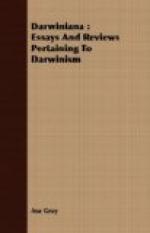After an illustration from the vegetable creation, Darwin adds:
“The naked skin on the head of a vulture is generally looked at as a direct adaptation for wallowing in putridity; and so it may be, or it may possibly be due to the direct action of putrid matter; but we should be very cautious in drawing any such inference, when we see that the skin on the head of the clean-feeding male turkey is likewise naked. The sutures in the skulls of young mammals have been advanced as a beautiful adaptation for aiding parturition, and no doubt they facilitate or may be indispensable for this act; but as sutures occur in the skulls of young birds and reptiles, which have only to escape from a broken egg, we may infer that this structure has arisen from the laws of growth, and has been taken advantage of in the parturition of the higher animals.”
All this, simply taken, is beyond cavil, unless the attempt to explain scientifically how any designed result is accomplished savors of impropriety.
In the other place, Darwin is contemplating the patent fact that “perfection here below” is relative, not absolute—and illustrating this by the circumstance that European animals, and especially plants, are now proving to be better adapted for New Zealand than many of the indigenous ones—that “the correction for the aberration of light is said, on high authority, not to be quite perfect even in that most perfect organ, the eye.” And then follows the second extract of the reviewer. But what is the position of the reviewer upon his own interpretation of these passages? If he insists that green woodpeckers were specifically created so in order that they might be less liable to capture, must he not equally hold that the black and pied ones were specifically made of these colors in order that they might be more liable to be caught? And would an explanation of the mode in which those woodpeckers came to be green, however complete, convince him that the color was undesigned?
As to the other illustration, is the reviewer so complete an optimist as to insist that the arrangement and the weapon are wholly perfect (quoad the insect) the normal use of which often causes the animal fatally to injure or to disembowel itself? Either way it seems to us that the argument here, as well as the insect, performs hari-kari. The Examiner adds:
“We should in like manner object to the word favorable, as implying that some species are placed by the Creator under unfavorable circumstances, at least under such as might be advantageously modified.”
But are not many individuals and some races of men placed by the Creator “under unfavorable circumstances, at least under such as might be advantageously modified?” Surely these reviewers must be living in an ideal world, surrounded by “the faultless monsters which our world ne’er saw,” in some elysium where imperfection and distress were never heard of! Such arguments resemble some which we often hear against the Bible, holding that book responsible as if it originated certain facts on the shady side of human nature or the apparently darker lines of Providential dealing, though the facts are facts of common observation and have to be confronted upon any theory.




